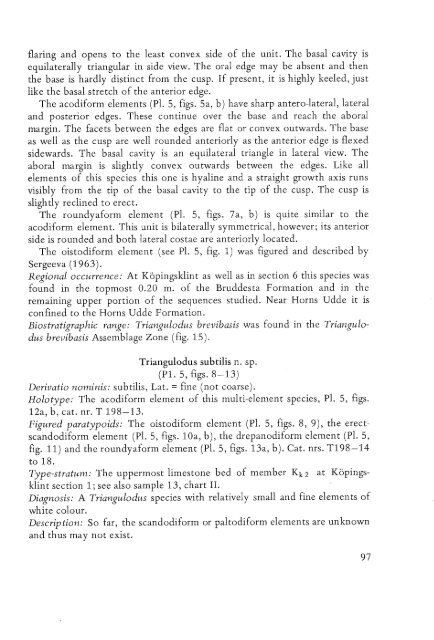UTRECHT MICROPALEONTOLOGICAL BUllETINS
UTRECHT MICROPALEONTOLOGICAL BUllETINS
UTRECHT MICROPALEONTOLOGICAL BUllETINS
Create successful ePaper yourself
Turn your PDF publications into a flip-book with our unique Google optimized e-Paper software.
flaring and opens to the least convex side of the unit. The basal cavity is<br />
equilaterally triangular in side view. The oral edge may be absent and then<br />
the base is hardly distinct from the cusp. If present, it is highly keeled, just<br />
like the basal stretch of the anterior edge.<br />
The acodiform elements (PI. 5, figs. Sa, b) have sharp antero-lateral, lateral<br />
and posterior edges. These continue over the base and reach the aboral<br />
margin. The facets between the edges are flat or convex outwards. The base<br />
as well as the cusp are well rounded anteriorly as the anterior edge is flexed<br />
sidewards. The basal cavity is an equilateral triangle in lateral view. The<br />
aboral margin is slightly convex outwards between the edges. Like all<br />
elements of this species this one is hyaline and a straight growth axis runs<br />
visibly from the tip of the basal cavity to the tip of the cusp. The cusp is<br />
slightly reclined to erect.<br />
The roundyaform element (PI. 5, figs. 7a, b) is quite similar to the<br />
acodiform element. This unit is bilaterally symmetrical, however; its anterior<br />
side is rounded and both lateral costae are anteriorly located.<br />
The oistodiform element (see PI. 5, fig. 1) was figured and described by<br />
Sergeeva (1963).<br />
Regional occurrence: At Kopingsklint as well as in section 6 this species was<br />
found in the topmost 0.20 m. of the Bruddesta Formation and in the<br />
remaining upper portion of the sequences studied. Near Horns Udde it is<br />
confined to the Horns Udde Formation.<br />
Biostratigraphic range: Triangulodus brevibasis was found in the Triangulodus<br />
brevibasis Assemblage Zone (fig. 15).<br />
Triangulodus subtilis n. sp.<br />
(PI. 5, figs. 8~ 13)<br />
Derivatio nominis: subtilis, Lat. = fine (not coarse).<br />
Holotype: The acodiform element of this multi-element species, PI. 5, figs.<br />
12a, b, cat. nr. T 198-13.<br />
Figured paratypoids: The oistodiform element (PI. 5, figs. 8, 9), the erectscandodiform<br />
element (PI. 5, figs. lOa, b), the drepanodiform element (PI. 5,<br />
fig. 11) and the roundyaform element (PI. 5, figs. 13a, b). Cat. nrs. T198-14<br />
to 18.<br />
Type-stratum: The uppermost limestone bed of member Kk2 at Kopingsklint<br />
section 1; see also sample 13, chart II.<br />
Diagnosis: A Triangulodus species with relatively small and fine elements of<br />
white colour.<br />
Description: So far, the scandodiform or paltodiform elements are unknown<br />
and thus may not exist.
















